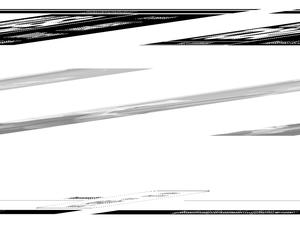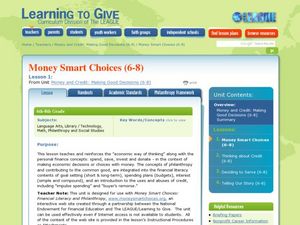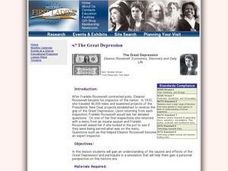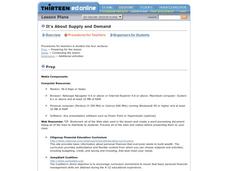Alabama Learning Exchange
I Know What You Did Last Summer: A Data Graphing Project
Young scholars participate in graphing data. In this graphing data lesson, students make a stem and leaf plot of their summer activities. Young scholars create numerous graphs on poster boards. Students discuss the differences between...
Curated OER
Learning to Live Responsibly Within One's Personal Resources
Students explore survival techniques in the light of their own values and personal situations. The differences between needs and wants and how consumerism effects the environment forms the main focus of this three lessons unit.
Curated OER
PAY CREDIT WHEN CREDIT IS DUE
Students learn about credit cards and scores and how to and not to use them. In this financial concept lesson, students are given hypothetical scenarios where they are able to apply learning's to given situations as they figure rates,...
Curated OER
Checks and Balances
Students discuss elements of financial planning. In this personal finance lesson, students practice filling out personal banking information. Students conduct research using the Internet and a PowerPoint presentation to find out how to...
Curated OER
Scoring a Financial Education
Students explore the concept of money management. In this money management lesson, students read an article about students taking a finance course in high school and college. Students discuss the importance of money management. Students...
Curated OER
Shopping!!!
Students explore money management. In this financial awareness instructional activity, students are given an amount of money and a sheet of objects to choose from to buy. Students choose only five objects they can afford to "buy."
Curated OER
There's No Business Like Bank Business
Students participate in a role play where they see how a bank works and how interest is paid by having money in the bank. In this bank lesson plan, students operate a bank and learn about saving, accounts, deposits, withdrawals,...
Curated OER
EBT-rimental
Students engage in a instructional activity that gives them the tools needed to become knowledgeable credit consumers. The companion website for the ITV program TV-411 is used to provide learners with an interactive experience of what...
Federal Reserve Bank
Expense Tracking
Where does all your money go? Individuals keep a record of the money they spend over the course of 30 days. They then categorize where they are spending their money and write an essay detailing their findings.
Curated OER
"Golden" Years?
The Golden Years? Upper graders may think retirement is a long way off, but in life everything is just around the corner. They consider what it means to retire and the current trend of parents working for their Students. They research...
Curated OER
Economics Using SimCity 2000
Fifth graders build a city and balance a budget for the population.
Curated OER
Money and Credit: Making Good Decisions
Students participate in activities that teach them how to manage money. In this managing money lesson plan, students set long and short term goals for economic success by having discussions, identifying benefits of saving, and...
Curated OER
The Sounds of Change
Students recognize that music brings out feelings and emotions in people. In this music themes lesson, students explore the relationships between culture and music. Students answer questions about favorite choices in music.
Curated OER
The Hundred Penny Box
Students compare how people save money in financial institutions, after reading the story, The Hundred Penny Box. They analyze the advantages of regular saving and how savings grow with compounding.
National First Ladies' Library
Eleanor Roosevelt: Economics, Discovery and Daily Life
Examine the causes and effects of the Great Depression and the role of Eleanor Roosevelt during the era. Pupils take an inventory of their home for wants and needs, and conduct online research on The Great Depression. They then convert...
Curated OER
Dear Presidential Diary
Students discover how a president spends the day. In this presidential history activity, students research primary sources in order to write their own diaries for presidents that include suggestions of laws, managing personnel,...
Curated OER
Check It Out
Pupils discuss the many processes involved with personal banking. They create their own budget based on their career choices. They also practice balancing a checkbook.
Curated OER
It's Your Future
Students learn about productive resources along with their requirements, supply and demand, savings, investments and interest rates. In this supply and demand instructional activity, students create a career plan and personal budget of...
Curated OER
IT IS ABOUT SUPPLY AND DEMAND.
Students learn that the price of an item is defined by its supply and demand. In this lesson students graph the relationship between demand and supply of various products, students also consider hidden costs.
Curated OER
Screen printing - Positive-Negative shape - Paper stencils
Pupils explore materials and experiment with stencil process. Students study positive verses negative shape. They experiment with color planning and learn what happens when colors overlap. They work with personal symbols and/or...
Curated OER
Taxes: Where Does Your Money Go?
Young scholars explore the concept of taxes. In this tax lesson, students investigate types of taxes and deductions taken out of a paycheck before they see it. Young scholars calculate the tax on a given dollar amount. Students...
Curated OER
Savings and Consumption
Learners engage in a study that is focused upon the practice of how financial savings is accumulated and spent. This is based upon the rate of consumption with spending. The lesson helps students to create a working budget according to a...
Curated OER
Where Does All the Money Go?
Students explore the concept of uses for money. In this uses for money lesson, students discuss ways in which money can be utilized such as spending, saving, investing, donating, etc. Students discuss the differences between needs and...
Curated OER
Shopping
Fifth graders simulate a shopping experience. Students are given a specified amount of money and they must spend it. Students choose five items they wish to purchase and determine if they can afford the items.

























